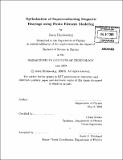Optimization of superconducting magnetic bearings using finite element modeling
Author(s)
Bryslawskyj, Jason (Jason Bogdan)
DownloadFull printable version (6.429Mb)
Other Contributors
Massachusetts Institute of Technology. Dept. of Physics.
Advisor
Ulrich Becker.
Terms of use
Metadata
Show full item recordAbstract
This project investigated the possibility of using superconducting bearings in large (3 - 100 MW) electric drives. Superconducting bearings are used to levitate the rotors inside electric drives via the Meiissner effect, whereby superconductors tend to repel magnetic flux. The Finite Element Method was used to model superconducting bearings and optimize their dimensions. Computer simulations were written to simulate the superconducting state as well as perform the optimization. Not only the effect of changing the dimensions of the bearings was explored, but also how effects specific to type II superconductors -such as the partial penetration of magnetic flux- could be used to improve bearing design were considered. Ultimately, a superconducting magnetic bearing with a carrying force of 3210 N was improved to obtain a carrying force of 5200 N.
Description
Thesis (S.B.)--Massachusetts Institute of Technology, Dept. of Physics, 2009. Includes bibliographical references (p. 33).
Date issued
2009Department
Massachusetts Institute of Technology. Department of PhysicsPublisher
Massachusetts Institute of Technology
Keywords
Physics.